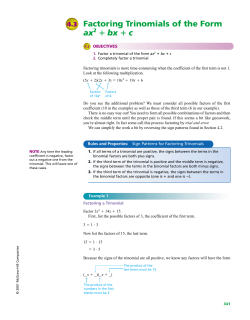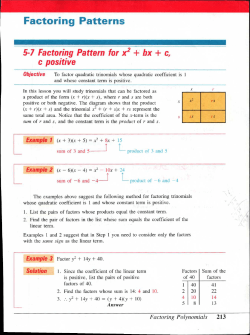
1-7 and 1-8 Factoring x2 + bx + c and ax2 + bx + c
1-7 and 1-8 Factoring x2 + bx + c and ax2 + bx + c Unit 1 English Casbarro • Recall: We have been multiplying binomials. The basic ones have a = 1. • (x + 5)(x + 3) = x2 + 3x + 5x + 15= x2 + 8x + 15 • Now that we are factoring, we will be moving backwards to the original binomials. • Remember that a quadratic equation is given by the form: ax2 + bx + c = 0 • When you are factoring, your factors will do 2 things: they will add to get the “b” they will multiply to get the “c” Now you try: Factor each trinomial by guess and check. 1a. x2 + 10x + 24 1b. x2 + 7x + 12 There are other ways to factor polynomials that are more exact. But the guess and check method works fine for basic polynomials. This is the way that you would remember how to factor basic trinomials. Factoring x2 + bx + c WORDS EXAMPLE To factor a quadratic trinomial of the form x2 + bx + c , find two factors of c whose sum is b. To factor x2 + 9x +18, look for factors of 18 whose sum is 9. Factors of 18 Sum 1 and 18 19 2 and 9 11 3 and 6 9 x2 + 9x + 18 = (x X X √ + 6)(x + 3) c is positive the factors have the same sign 1) b is positive both factors are positive 2) b is negative both factors are negative You try the following problems. Factor each trinomial. 1. x2 + 8x +12 2. x2 – 5x + 6 3. x2 + 13x + 42 4. x2 – 13x + 40 The “c” is not always positive– this is what you do if it’s negative. Factoring x2 + bx – c WORDS To factor a quadratic trinomial of the form x2 + bx – c , find two factors of c whose difference is b. EXAMPLE To factor x2 + 3x – 18, look for factors of 18 whose difference is 3. Factors of 18 Difference 1 and 18 -17 (1 – 18) X, 17 (18 – 1) X 2 and 9 - 7 (2 – 9) X , 7 (9 – 2) X 3 and 6 - 3 (3 – 6) X, 3 (6 – 3) √ x2 + 3x – 18 = (x + 6)(x – 3) c is negative the factors have different signs 1) b is positive larger factor is positive 2) b is negative larger factor is negative Now you try: 3a. x2 + 2x – 15 3b. x2 – 6x + 8 3c. x2 – 8x - 20 Turn in the following problems 1. The equation for the motion of an object with constant acceleration is d=vt + ½at2, where d is the distance traveled in feet per second, a is acceleration in feet per second squared, and t is time in seconds. a. Janna has two toy race cars on a track. One starts at velocity 0 ft/s, and accelerates at 2 ft/s2. Write an equation for the distance the car travels in time, t. b. The second car travels at a constant speed of 4 ft/s. Write an equation for the distance the second car travels in time, t. (Hint: When speed is constant, acceleration is 0 ft/s2) c. Write an equation to determine when the cars have traveled the same distance. What is the time? 2. The area of a rectangular fountain is (x2 + 12x + 20) ft2. The width is (x + 2) ft. a. Find the length of the fountain. b. A 2-foot walkway is built around the fountain. Find the dimensions of the outside border of the walkway. c. Find the total area covered by the fountain and walkway. 1-8: Factoring ax2 + bx + c There are two ways of factoring this trinomial that I will show you. 1) guess and check 2) grouping Guess and Check works just as well as Grouping, but it might take longer. Recall: (3x + 2)(2x + 5) = 6x2 + 19x + 10 The first term is found by multiplying the First numbers. The last term is found by multiplying the Last numbers. The middle term is found by multiplying the Inside and the Outside terms and adding them together. When you are trying to factor trinomials of this type, you will write down 2 sets of parentheses, and fill in the blanks with possible factors of the first and the last numbers. You will then check it by adding to see if your factors will give you the middle term. Now you try: 1a. 6x2 + 11x + 3 1b. 3x2 – 2x – 8 It’s not difficult when c is positive. You will be adding the products of the inner and outer products to find the middle term. You can make a table to see which products work. So, the factors would be (1x + 4)(2x + 3) It works exactly the same way when the middle term is negative and c is positive. The factors will just be negative, instead of positive. (Remember that negative x negative = positive) So, the factors would be (1x – 2)(5x – 4) Now you try: a. 6x2 – 17x + 5 b. 9x2 – 15x + 4 c. 3x2 + 13x + 12 Factoring by splitting the middle term: 4x2 + 16x + 15 Multiply the first term by the last term. 4(15) = 60 Find all of the factors of that product. 60 1, 60 2, 30 Which set adds up to 16? 3, 20 4, 15 5, 12 6, 10 Use the 2 factors whose sum is b and split the middle term into 2 separate terms. 4x2 + 6x + 10x + 15 Once you have the 4 terms, you will split them into 2 sets of 2 terms to take advantage of the distributive property. 4x2 + 6x = 2x (2x + 3) 10x + 15 = 5 (2x + 3) they are both (2x + 3) So, the factors would be (2x + 5)(2x + 3) Factoring by splitting the middle term, c < 0: 4x2 + 19x – 5 Multiply the first term by the last term. 4(5) = 20 Find all of the factors of that product. 20 1, 20 2, 10 Which set subtracts to 19? 4, 5 Use the 2 factors whose difference is b and split the middle term into 2 separate terms. 4x2 + 20x – 1x – 5 Once you have the 4 terms, you will split them into 2 sets of 2 terms to take advantage of the distributive property. 4x2 + 20x = 4x (x - 5) – 1x + 5 = –1 (x – 5) they are both (x – 5) So, the factors would be (4x – 1)(x – 5) Now you try: a. 6x2 + 7x – 3 b. 6x2 – 13x + 6 Turn in the following problems 1. The equation for the motion of an object with constant acceleration is d= 2t2, gives the distance from the start point of a toy boat that starts at rest and accelerates at 4 cm/sec2 . The equation d = 10t – 8 gives the distance from the start point of a second boat that starts at rest 8 cm behind the first and travels at a constant speed of 10 cm/sec. a. Janna has two toy race cars on a track. One starts at velocity 0 ft/s, and accelerates at 2 ft/s2. Write an equation for the distance the car travels in time, t. b. The second car travels at a constant speed of 4 ft/s. Write an equation for the distance the second car travels in time, t. (Hint: When speed is constant, acceleration is 0 ft/s2) an equation tobeen determine the cars 2. The heightc.ofWrite a football that has thrownwhen or kicked canhave be described 2 +same traveled the the time? by the expression –16t vt +distance. h where tWhat is theistime in seconds, v is the initial upward velocity and h is the initial height in feet. a. Write an expression for the height of a football when the initial velocity is 20 feet/sec and the initial height is 6 ft. b. Factor your expression from part a. c. Find the height of the football after 1 second.
© Copyright 2025


















